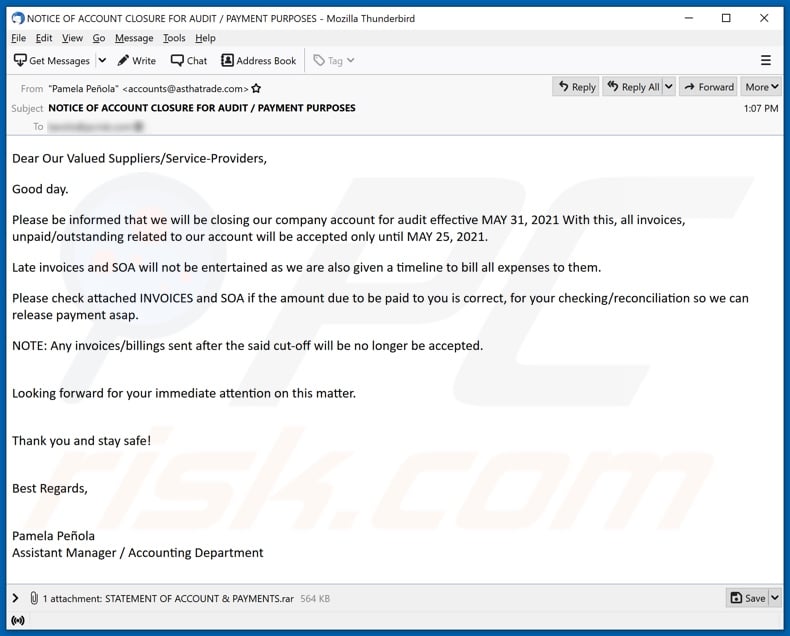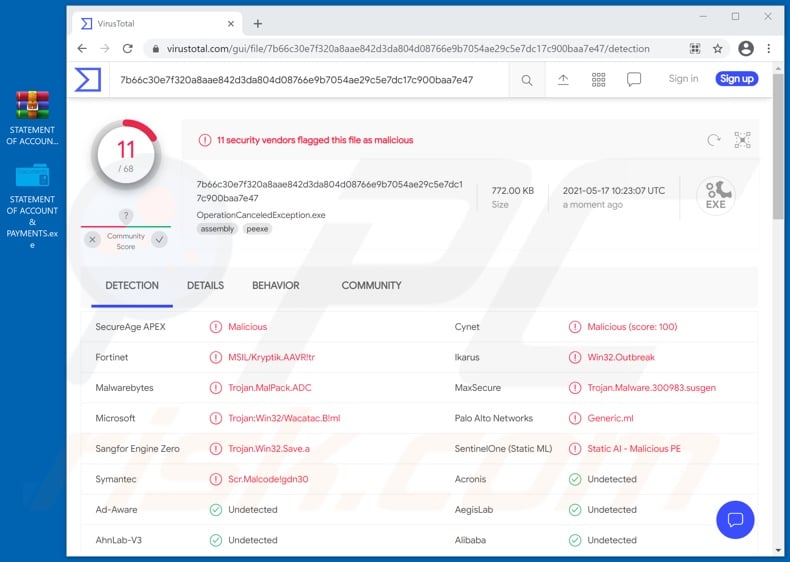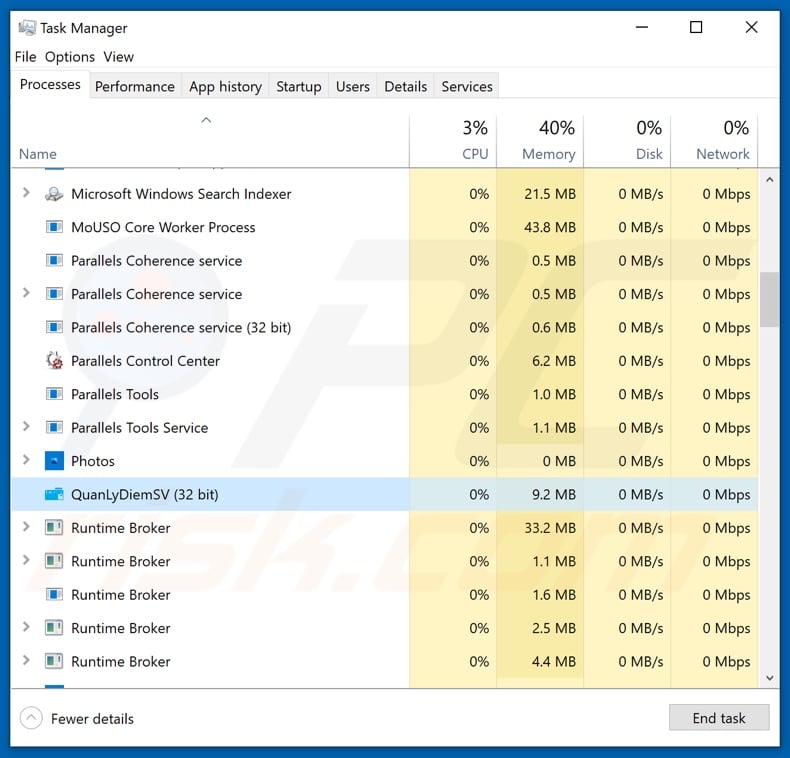Do not trust the "NOTICE OF ACCOUNT CLOSURE FOR AUDIT" malicious email
Phishing/ScamAlso Known As: NOTICE OF ACCOUNT CLOSURE FOR AUDIT spam
Get free scan and check if your device is infected.
Remove it nowTo use full-featured product, you have to purchase a license for Combo Cleaner. Seven days free trial available. Combo Cleaner is owned and operated by RCS LT, the parent company of PCRisk.com.
What is the "NOTICE OF ACCOUNT CLOSURE FOR AUDIT" scam email?
"NOTICE OF ACCOUNT CLOSURE FOR AUDIT" is the name of a malware-proliferating spam campaign. This term defines a mass-scale operation during which thousands of deceptive emails are sent.
The letters distributed through this campaign - address the recipient as a supplier/service provider and request them to review their account and payment statements. However, instead of containing this documentation, the email attachment is designed to infect systems with the NanoCore RAT (Remote Access Trojan) - upon opening.
Malware within this classification operates by enabling remote access and control over compromised machines. These trojans can have a wide variety of heinous functionalities, which pose a broad range of serious threats.

The scam emails with the subject/title "NOTICE OF ACCOUNT CLOSURE FOR AUDIT / PAYMENT PURPOSES" (may vary) request their suppliers/ service providers (the recipients) to review the attached statement of account and payments. According to the deceptive letters, this information must be reviewed before the senders' fake company's audit.
During the audit, the company will be closed, and new invoices/billings will not be accepted, nor will past payment errors be addressed. However, once the fake statement is opened - this virulent file starts NanoCore RAT's download/installation.
Remote access trojans enable cyber criminals to access and control their victims' devices. These malicious programs can control hardware and software.
Typically, RATs are used to steal sensitive and personal information. The data-stealing abilities of these trojans can include file exfiltration (download), information extraction from browsers and other installed applications, keylogging (key-stroke recording), and so on.
Another common feature of RATs is spying, e.g., taking screenshots, recording/live-streaming audio/video via integrated or connected microphones and cameras, etc. Furthermore, the trojans are often able to cause chain infections (i.e., download/install additional malware).
Hence, they can be used to infect the system with more trojans, ransomware, cryptocurrency miners, and so forth. To summarize, by trusting the "NOTICE OF ACCOUNT CLOSURE FOR AUDIT" scam emails, users can experience system infections, severe privacy issues, financial losses, and identity theft.
If it is suspected or known that NanoCore RAT (or other malware) has already infected the device, it is crucial to use anti-virus software to remove it immediately.
| Name | NOTICE OF ACCOUNT CLOSURE FOR AUDIT spam |
| Threat Type | Trojan, password-stealing virus, banking malware, spyware. |
| Hoax | Scam emails request recipients to review their account/payment statements, due to an upcoming company audit. |
| Attachment(s) | STATEMENT OF ACCOUNT & PAYMENTS.rar containing STATEMENT OF ACCOUNT & PAYMENTS.exe (filenames may vary) |
| Detection Names | Avast (Win32:RATX-gen [Trj]), BitDefender (Trojan.GenericKD.36919082), ESET-NOD32 (A Variant Of MSIL/Kryptik.AAYN), Kaspersky (HEUR:Trojan-Spy.MSIL.Noon.gen), Microsoft (Trojan:MSIL/AgentTesla.AM!MTB), Full List Of Detections (VirusTotal) |
| Symptoms | Trojans are designed to stealthily infiltrate the victim's computer and remain silent, and thus no particular symptoms are clearly visible on an infected machine. |
| Payload | NanoCore |
| Rogue Process Name | QuanLyDiemSV (process name may vary) |
| Distribution methods | Infected email attachments, malicious online advertisements, social engineering, software 'cracks'. |
| Damage | Stolen passwords and banking information, identity theft, the victim's computer added to a botnet. |
| Malware Removal (Windows) |
To eliminate possible malware infections, scan your computer with legitimate antivirus software. Our security researchers recommend using Combo Cleaner. Download Combo CleanerTo use full-featured product, you have to purchase a license for Combo Cleaner. 7 days free trial available. Combo Cleaner is owned and operated by RCS LT, the parent company of PCRisk.com. |
"SGBM Email Virus", "Spring Marine Management S.A.", "Consignment Was Booked Via DHL Express", and "Alibaba Email Virus" are a few examples of malware-spreading spam campaigns.
The emails sent through these large-scale operations are usually disguised as "official", "urgent", "important", "priority", and similar. However, proliferating malicious software is not the sole use of spam mail.
These emails are also used to facilitate phishing and other scams. It is highly recommended to exercise caution with incoming emails - to avoid infecting the system or getting scammed.
How did "NOTICE OF ACCOUNT CLOSURE FOR AUDIT email virus" infect my computer?
Systems are infected via virulent files distributed through spam campaigns. The files can be attached to the emails, or the letters contain download links of malicious content.
Infectious files can be in various formats, e.g., archives (RAR, ZIP, etc.), executables (.exe, .run, etc.), PDF and Microsoft Office documents, JavaScript, and so forth. When the files are opened - malware download/installation is jumpstarted.
For example, Microsoft Office documents cause infections by executing malicious macro commands. This process begins the moment a document is opened in Microsoft Office versions released before 2010.
Newer versions have "Protected View" mode that prevents automatic execution of macros. Instead, users are asked to enable editing/content (i.e., macro commands), and they are warned of the potential threats
How to avoid installation of malware?
Suspicious and irrelevant emails must not be opened - especially any attachments or links present in them. It is recommended to use Microsoft Office versions released after 2010.
Additionally, all downloads must be done from official and verified sources - as untrustworthy channels often proliferate malicious and unwanted content. Software also has to be activated and updated with tools/functions provided by legitimate developers, since ones obtained from third-parties are likely to cause infections.
To ensure device and user safety, it is paramount to have a reputable anti-virus/anti-spyware suite installed and kept up-to-date. Furthermore, these programs have to be used to perform regular system scans and remove detected threats and issues.
If you've already opened "NOTICE OF ACCOUNT CLOSURE FOR AUDIT" attachment, we recommend running a scan with Combo Cleaner Antivirus for Windows to automatically eliminate infiltrated malware.
Text presented in the "NOTICE OF ACCOUNT CLOSURE FOR AUDIT" scam email letter:
Subject: NOTICE OF ACCOUNT CLOSURE FOR AUDIT / PAYMENT PURPOSES
Dear Our Valued Suppliers/Service-Providers,
Good day.
Please be informed that we will be closing our company account for audit effective MAY 31, 2021 With this, all invoices, unpaid/outstanding related to our account will be accepted only until MAY 25, 2021.
Late invoices and SOA will not be entertained as we are also given a timeline to bill all expenses to them.
Please check attached INVOICES and SOA if the amount due to be paid to you is correct, for your checking/reconciliation so we can release payment asap.
NOTE: Any invoices/billings sent after the said cut-off will be no longer be accepted.
Looking forward for your immediate attention on this matter.
Thank you and stay safe!
Best Regards,
Pamela Peñola
Assistant Manager / Accounting Department
Screenshot of VirusTotal detections of the malicious attachment distributed via "NOTICE OF ACCOUNT CLOSURE FOR AUDIT" spam campaign ("STATEMENT OF ACCOUNT & PAYMENTS.exe" filename):

Screenshot of the malicious executable's process on Windows Task Manager ("QuanLyDiemSV" process name):

Instant automatic malware removal:
Manual threat removal might be a lengthy and complicated process that requires advanced IT skills. Combo Cleaner is a professional automatic malware removal tool that is recommended to get rid of malware. Download it by clicking the button below:
DOWNLOAD Combo CleanerBy downloading any software listed on this website you agree to our Privacy Policy and Terms of Use. To use full-featured product, you have to purchase a license for Combo Cleaner. 7 days free trial available. Combo Cleaner is owned and operated by RCS LT, the parent company of PCRisk.com.
Quick menu:
- What is NOTICE OF ACCOUNT CLOSURE FOR AUDIT spam?
- Types of malicious emails.
- How to spot a malicious email?
- What to do if you fell for an email scam?
Types of malicious emails:
![]() Phishing Emails
Phishing Emails
Most commonly, cybercriminals use deceptive emails to trick Internet users into giving away their sensitive private information, for example, login information for various online services, email accounts, or online banking information.
Such attacks are called phishing. In a phishing attack, cybercriminals usually send an email message with some popular service logo (for example, Microsoft, DHL, Amazon, Netflix), create urgency (wrong shipping address, expired password, etc.), and place a link which they hope their potential victims will click on.
After clicking the link presented in such email message, victims are redirected to a fake website that looks identical or extremely similar to the original one. Victims are then asked to enter their password, credit card details, or some other information that gets stolen by cybercriminals.
![]() Emails with Malicious Attachments
Emails with Malicious Attachments
Another popular attack vector is email spam with malicious attachments that infect users' computers with malware. Malicious attachments usually carry trojans that are capable of stealing passwords, banking information, and other sensitive information.
In such attacks, cybercriminals' main goal is to trick their potential victims into opening an infected email attachment. To achieve this goal, email messages usually talk about recently received invoices, faxes, or voice messages.
If a potential victim falls for the lure and opens the attachment, their computers get infected, and cybercriminals can collect a lot of sensitive information.
While it's a more complicated method to steal personal information (spam filters and antivirus programs usually detect such attempts), if successful, cybercriminals can get a much wider array of data and can collect information for a long period of time.
![]() Sextortion Emails
Sextortion Emails
This is a type of phishing. In this case, users receive an email claiming that a cybercriminal could access the webcam of the potential victim and has a video recording of one's masturbation.
To get rid of the video, victims are asked to pay a ransom (usually using Bitcoin or another cryptocurrency). Nevertheless, all of these claims are false - users who receive such emails should ignore and delete them.
How to spot a malicious email?
While cyber criminals try to make their lure emails look trustworthy, here are some things that you should look for when trying to spot a phishing email:
- Check the sender's ("from") email address: Hover your mouse over the "from" address and check if it's legitimate. For example, if you received an email from Microsoft, be sure to check if the email address is @microsoft.com and not something suspicious like @m1crosoft.com, @microsfot.com, @account-security-noreply.com, etc.
- Check for generic greetings: If the greeting in the email is "Dear user", "Dear @youremail.com", "Dear valued customer", this should raise suspiciousness. Most commonly, companies call you by your name. Lack of this information could signal a phishing attempt.
- Check the links in the email: Hover your mouse over the link presented in the email, if the link that appears seems suspicious, don't click it. For example, if you received an email from Microsoft and the link in the email shows that it will go to firebasestorage.googleapis.com/v0... you shouldn't trust it. It's best not to click any links in the emails but to visit the company website that sent you the email in the first place.
- Don't blindly trust email attachments: Most commonly, legitimate companies will ask you to log in to their website and to view any documents there; if you received an email with an attachment, it's a good idea to scan it with an antivirus application. Infected email attachments are a common attack vector used by cybercriminals.
To minimise the risk of opening phishing and malicious emails we recommend using Combo Cleaner Antivirus for Windows.
Example of a spam email:

What to do if you fell for an email scam?
- If you clicked on a link in a phishing email and entered your password - be sure to change your password as soon as possible. Usually, cybercriminals collect stolen credentials and then sell them to other groups that use them for malicious purposes. If you change your password in a timely manner, there's a chance that criminals won't have enough time to do any damage.
- If you entered your credit card information - contact your bank as soon as possible and explain the situation. There's a good chance that you will need to cancel your compromised credit card and get a new one.
- If you see any signs of identity theft - you should immediately contact the Federal Trade Commission. This institution will collect information about your situation and create a personal recovery plan.
- If you opened a malicious attachment - your computer is probably infected, you should scan it with a reputable antivirus application. For this purpose, we recommend using Combo Cleaner Antivirus for Windows.
- Help other Internet users - report phishing emails to Anti-Phishing Working Group, FBI’s Internet Crime Complaint Center, National Fraud Information Center and U.S. Department of Justice.
Share:

Tomas Meskauskas
Expert security researcher, professional malware analyst
I am passionate about computer security and technology. I have an experience of over 10 years working in various companies related to computer technical issue solving and Internet security. I have been working as an author and editor for pcrisk.com since 2010. Follow me on Twitter and LinkedIn to stay informed about the latest online security threats.
PCrisk security portal is brought by a company RCS LT.
Joined forces of security researchers help educate computer users about the latest online security threats. More information about the company RCS LT.
Our malware removal guides are free. However, if you want to support us you can send us a donation.
DonatePCrisk security portal is brought by a company RCS LT.
Joined forces of security researchers help educate computer users about the latest online security threats. More information about the company RCS LT.
Our malware removal guides are free. However, if you want to support us you can send us a donation.
Donate
▼ Show Discussion